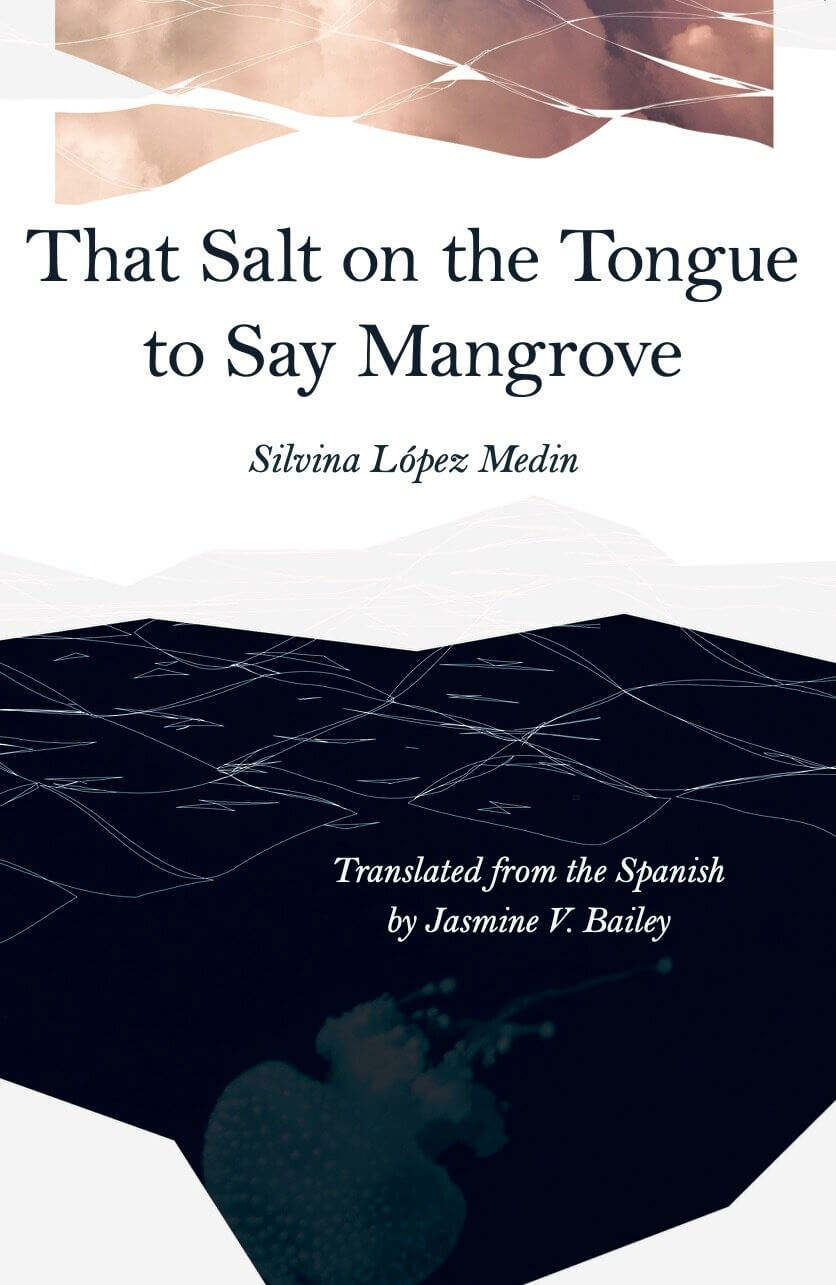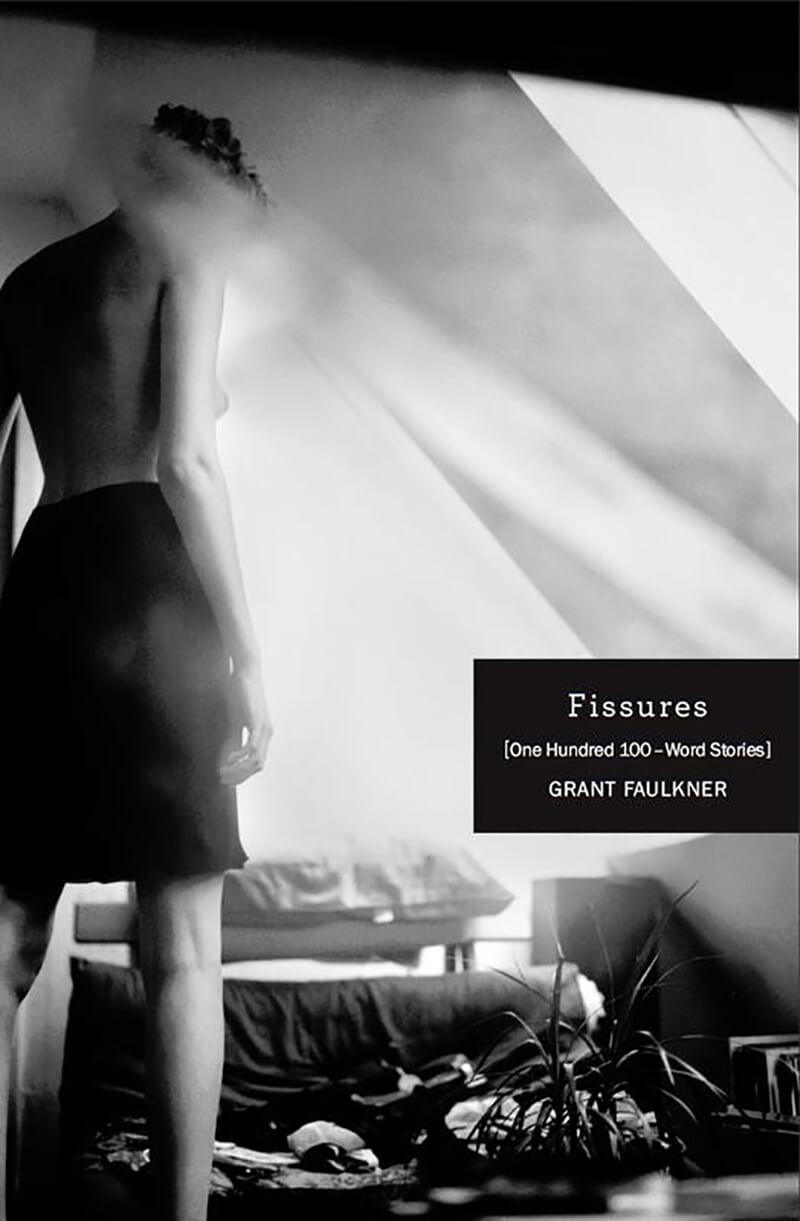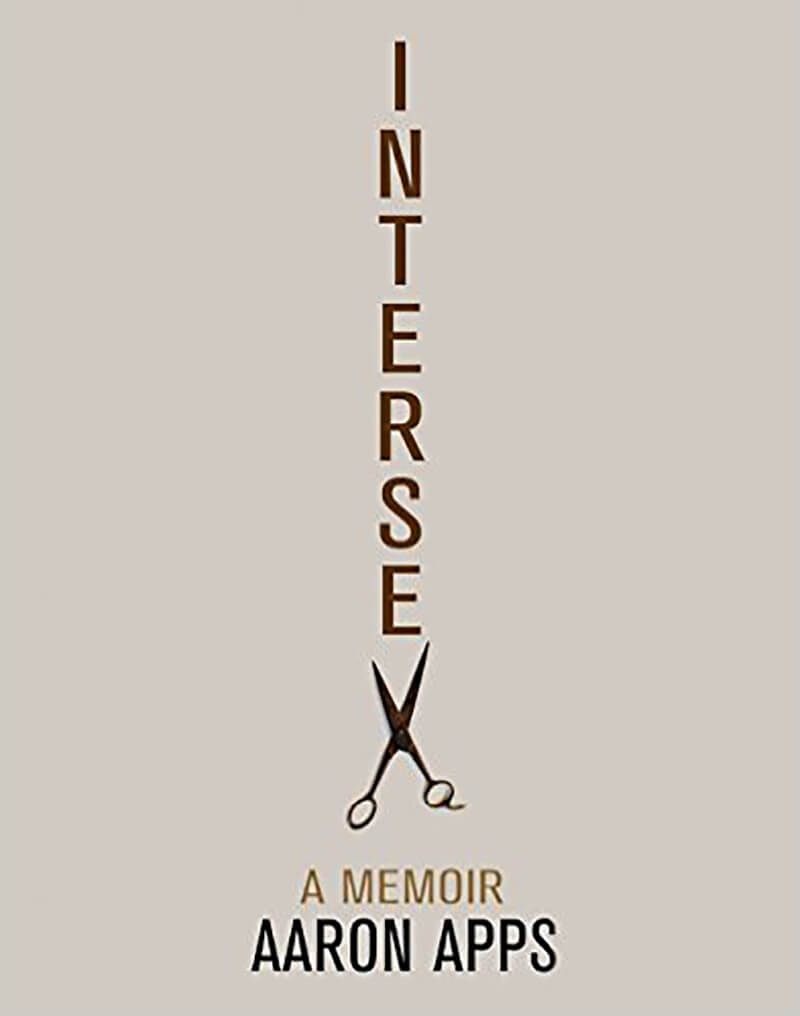
Review
That Salt on the Tongue to Say Mangrove
by Silvina López Medín Translated by Jasmine V. Bailey
Carnegie Mellon University PressISBN: 978-0887486715
Review by Kristin Dykstra
This is a book that channels readers first in one direction, then another. The title of the collection by Silvina López Medín (Argentina/US) gives the power of speech to salt, which speaks a plant, perhaps a landscape. Its opening sequence of poems, one of three sequences in the book, sketches an environment both physical and social. It suggests documentation of a remembered place and time, “A la sombra de esos árboles / In the Shadow of Those Trees.”
Family members appear, hinting at stories shared across generations: uncles, aunts, a grandfather. But as the poems move forward, elders fade away, taking stories and expectations with them. That process leads away from the coherence of biography and toward a world of displacement. We are invited to think about how people do and don’t connect, how we remember, and also how we forget.
The book’s fourth poem, “Conversation,” performs more redirection, for it does not portray a conversation. It does reflect on someone’s preparation to converse, and a self “fuera de ritmo” (“out of step”) emerges. The speaker announces that she has done everything
como quien ve un cartel que señala
una montaña y piedras
piedras que caen,
no sabía detener ese derrumbe.
[like someone who sees a sign that warns / of a mountain and stones / stones falling, / I didn’t know how to stop that crumbling (lines 14-18)].
Things crumble away, people vanish from landscapes. In a short poem, the speaker’s father passes by – will he come back? No: “el artefacto armado por mi padre” (“the artifact my father fashioned” (line 1)) takes center stage. The speaker says of this slingshot, “lo he dejado caer en algún fondo” (“I’ve let it fall into some lost corner” [line 6]). Abandonment and loss surface as the actions at hand.
An elderly man holds our view longer in “Notes for a Fado,” one of the core poems of the book. His story turns on a partial execution of a dance. He misses some motions, loses beats. At the center of his poem, López asks, “Es ese el espacio entre las cosas / que Cage pedía no olvidar?” (“Is that the space between things / that Cage asked us not to forget?” [lines 10-11])
From this point forward a narrative consciousness may come and go from López’s poems, but with such emphasis on gaps and turning away, what happens to communication, to community? “Notes for a Fado” ends by depicting an audience who, watching the man, are “convinced, still, that everything must be whole.” Here the translator, Jasmine Bailey, has shifted the desired wholeness into a noun; while her alteration works well, I’m considering López’s emphasis on action so will note that the original Spanish invokes “la necesidad de completar.” The poet portrays our strong desire to make complete, as verb.
Where partial communication is our best-case result, completion becomes just a streak of utopian color on the distant horizon. Once the opening section ends, we never return to the zone of satisfying narrative that the beginning dangled in front of us.
López segments her poems in the second portion, “Poemas del ecuador/ Poems from the Equator,” in a notably different way, highlighting her change of course. Spurts of line rise, then fall away from the surface of the page. In this reduced plane of vision, López guides the reader to examine construction:
Acá se nota el doblez
justo en la mitad
el cambio de rumbo de la sombra.
[Here you can see the fold / right in the middle / the shade changing course. (section 3, lines 1-3]]
The material under construction varies. Text, yes, but also López suggests fabric, naming a grandmother’s Singer sewing machine in the second poem. She foregrounds the splitting of images, then the people who dwell on breakage, seeking “una versión fría del paisaje” (“a cold version of the landscape,” section 4, line 2). Pushing oneself toward the creative limit, the edge or seam between pieces, is a defining act:
empujar el hielo
así la línea se hace grieta,
un hocico se asoma a respirar
tiene algo de animal polar quien escribe
frente al vidrio roto de la ventana
resoplando
a ras, a ras, a ras.
[“to push the ice / so that the line becomes a fault, / a snout pokes out to breathe / people who write in front of a window’s broken glass / have something of a polar animal in them, / puffing / just there, just there, just there.” (section 4, lines 3-9).
The ebb and flow of this sequence delivers a dotted line, a slit, a sandbar, variations on Cage’s gap. If confrontation with breakage does define the self, these moments reveal, at intervals, the speaker trying to decide whether she too will become so cold, so hard, so sorrowful:
Habrá que entrar en zona de aguas vivas
que me dejen su marca
reverso de blandura
[I must have to wade into whitewater / for it to leave its mark on me / the opposite of tenderness (section 8, lines 1-3)]
The third sequence uses the same title in both languages, “Pentimento,” though its definition appears only in the English: “Physical evidence in a painting that shows that the artist has altered the work, usually reflecting a shift in intentions” (49). Recalling the poet’s changes of course in the first two sequences, I take the final section as a prompt to see the book as a series of shifting channels.
“the diversion of desires toward an alternate channel should no longer be surprising. The diversion is the point.”
“Pentimento” opens with emphasis on construction and its others: scraps that may or may not come together, acts of destruction, crossings out. These lead toward its sixth poem, which begins with a question that underlines the entire project of That Salt on the Tongue to Say Mangrove: “Eso que escribís te pasó?” (“Did what you’re writing happen to you?” [line 1]).
The question is not italicized in the Spanish. Bailey has made various minor shifts for the English translation with subtlety and care. At this question, “Did what you’re writing happen to you?,” her addition of italics in the English translation draws attention to the feel of dialogue, which has elsewhere been deferred or evaded. That is, her italics highlight the presence of a questioner.
The poet/respondent resists the question, responding: “Shh.” Yet the question will return – along with the translator’s italics, and the respondent’s resistance to the question – In the book’s final poem. Why?
This query makes assumptions: it presumes a past, an event, or sharing of biography as entry points for comprehension of one person by another.
¿Lo que escribís te pasó?
No poder decir
el lago de otra forma.
[Did what you’re writing happen to you? / No other way / to say lake. (lines 1-3)]
At this stage, the diversion of desires toward an alternate channel should no longer be surprising. The diversion is the point. In sum: the respondent declines to (1) adopt the past tense that the questioner supposes to be essential; (2) confirm an event; (3) exit the awareness of language or make the poem’s “saying” subsidiary to the delivery of information. The questioner thinks there is a back story, desires it; the respondent shunts this desire aside. The questioner wants something concrete; the respondent flows, like water circling under roots at a shoreline, in what seems to be an errant, sidewise direction. Her refusal leaves us with “no other way / to say”: a sole state of possibility.
The importance of both actions, insistent questioning and stubborn responding via one single rerouted possibility, expands. Their second iteration begins with the same question, and this time the respondent replies in instructions:
¿Lo que escribís te pasó?
Deformar el lago
volverlo laguna
cosa olvidada
vacío.
[Did what you’re writing happen to you? / Warp the lake / make it a pond / something forgotten / empty.]
If the poem ended here, it would seem to consign all event, all memory, all relation to oblivion. The command to make an empty pond might evoke human mortality, a conventional endpoint.
Instead this conversation continues into its final sequence:
¿Lo que escribís te pasó?
Nadar es empujar el agua, así
se empujan las palabras
a otro ritmo, lo que queda
es ir hasta el fondo, uno aguanta
la respiración, para decir luego: ahí estuve
de eso se trata
un lago.
[Did what you’re writing happen to you? / Swimming is pushing water, the same way / we push words / in different rhythms, and what remains / is to dive to the bottom, you hold / your breath, to later say: I was there / and what it’s about is / a lake.]
The poet/respondent allows for some partial story, an unfinished event – and will also permit us a vibrant physical presence, a future action, a relation to the past, and a potentially real lake. These possibilities manifest only in a downward dive through language, breath suspended.
Insofar as That Salt on the Tongue to Say Mangrove is “about” things that happened, it can only be so in the mediation of all things by language – language moving as if water, currents in motion, layering visibility and blur. The action of the swimmer, the motion of her language: meaning lies inside her willful errancy.
That Salt on the Tongue to Say Mangrove includes no context other than blurbs. One must approach this refusal to contextualize (not knowing how the decision was made, or by whom) with the expectation that absence is productive. The lack of narration does force confrontation with the poet’s language, be that in the original Spanish or Bailey’s translation. It potentially directs us toward spaces between the two languages, applying Cage’s call to mind the gap to the realm of translation. Silence may be both cold and right for this book. Its conceptual slant toward partial communication validates the claim, “no other way / to say” (as stated in the closing poem), diverting readers away from dependence on other sorts of saying.
Of course, the existence of a translation belies this rule of singularity. Even recognizing the value of silence, it is disappointing not to see a page or two sharing observations by the translator. López will surely be on the literary scene for years to come, and it would be excellent to support her with commentary. In my experience with translations, the lack of commentary regarding women writers has been a companion absence to the statistically lower translation of their work. This too is a cold hard fact with consequences for how a book will or will not get read, so I propose adopting an icy outlook and imagining that the presence of context could be conceptually significant. Translators remark on a collection based on an experience and perspective that literally no one else shares. Given Bailey’s careful renditions of these poems, I would love to know what she would say, and perhaps even more, how (as an accomplished writer herself) she would perform her saying.
It’s refreshing to see Bailey’s name appear below that of López, first on the front cover, and then on the back where notes and photos for both writers appear. With this choice, Carnegie Mellon University Press aligns itself with a current movement to get translators visibility on book covers 1. The result reminds me of a saying from Robert Creeley: “Poetry is a team sport; you can’t play it all by yourself.” I am not sure how often the athletic analogy has been applied to women. With López’s final imagery of swimming in mind, I’ll rename this collection as a relay, executed by an excellent team.
- In September 2021, the Society of Authors drew substantial international attention to the call to name translators on the front covers of books, by hosting an open letter written by Jennifer Croft and Mark Haddon to publishers (https://www2.societyofauthors.org/translators-on-the-cover/)
About the Author
 Kristin Dykstra is principal translator of The Winter Garden Photograph, by Reina María Rodríguez, winner of the 2020 PEN Award for Poetry in Translation and finalist for the National Translation Award. She organized and introduced a May 2021 dossier dedicated to Rodríguez in the digital magazine Latin American Literature Today. With Kent Johnson, she co-edited Materia Prima, an anthology featuring Uruguay’s Amanda Berenguer, with a team of translators; Materia Prima was a finalist for the 2020 Best Translated Book Award. Previously she translated numerous poetry editions, such as books by Juan Carlos Flores, Marcelo Morales, Tina Escaja, Rodríguez, and others. Her most recent scholarly chapters examine contemporary poetry by Daniel Borzutzky (US) and Soleida Ríos (Cuba). Selections from Dykstra’s own current poetry manuscript appear in Lana Turner: A Journal of Poetry and Opinion, Seedings, Clade Song, Almost Island, The Hopper, La Noria and El Nieuwe Acá (both with tr. to Spanish by Escaja), and Acrobata (tr. to Portuguese by Floriano Martins). Her essay “Ensenada,” co-translated with Juan Manuel Tabío, appeared in Rialta in September 2021.
Kristin Dykstra is principal translator of The Winter Garden Photograph, by Reina María Rodríguez, winner of the 2020 PEN Award for Poetry in Translation and finalist for the National Translation Award. She organized and introduced a May 2021 dossier dedicated to Rodríguez in the digital magazine Latin American Literature Today. With Kent Johnson, she co-edited Materia Prima, an anthology featuring Uruguay’s Amanda Berenguer, with a team of translators; Materia Prima was a finalist for the 2020 Best Translated Book Award. Previously she translated numerous poetry editions, such as books by Juan Carlos Flores, Marcelo Morales, Tina Escaja, Rodríguez, and others. Her most recent scholarly chapters examine contemporary poetry by Daniel Borzutzky (US) and Soleida Ríos (Cuba). Selections from Dykstra’s own current poetry manuscript appear in Lana Turner: A Journal of Poetry and Opinion, Seedings, Clade Song, Almost Island, The Hopper, La Noria and El Nieuwe Acá (both with tr. to Spanish by Escaja), and Acrobata (tr. to Portuguese by Floriano Martins). Her essay “Ensenada,” co-translated with Juan Manuel Tabío, appeared in Rialta in September 2021.



